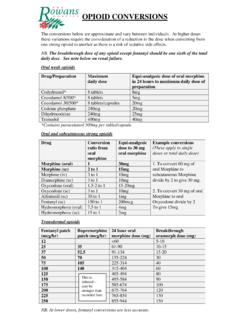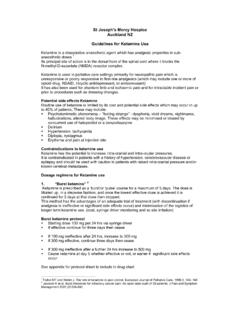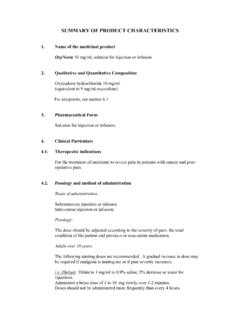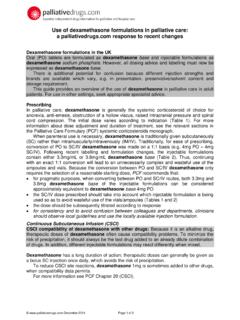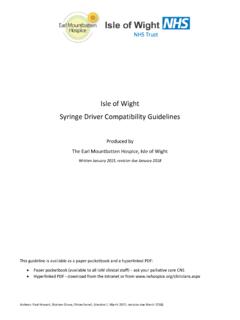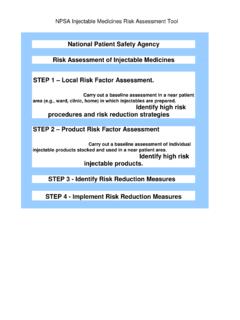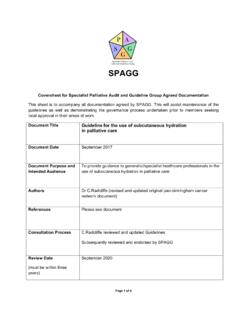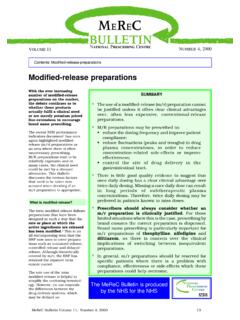Transcription of Anticipatory drugs and syringe driver chart V2
1 In hoursOut of hoursDiscontinue prescriptions by clearly crossing through the whole prescription, with the date discontinued & signature. Do not alter an existing prescription always rewrite a new syringe driver prescription in a new boxThere is space for 4 syringe driver prescriptions Always check for for prescribersCancel drugs Opioids Use 20mL syringes or 30mL if larger volume required. Syringes Information for nursesSt Leonard s HospicecYork Teaching Hospital NHS Foundation Trust. Owner: Dr Anne Garry. Issue Date: November 2015. Review Date: November 2018 Version: 2 Approved by: Drug and Therapeutic Committee Order number: FY03000081 website for algorithms and conversion charts Services/GP hub or Services/palliative care Use clear adhesive dressing over the infusion site Patients with syringe drivers should be checked every 4 hours in institutions and as a minimum every 24 hours in a patient's home. If the patient requires additional medication (analgesic/ sedative/antiemetic etc) give a subcutaneous dose of the appropriate drug, as prescribed on the prn section of the drug chart .
2 If ineffective seek medical advice. NB each non- opioid drug has a 24 hour maximum. If you are giving opioids ( , oxycodone, alfentanil) to a patient who has not had one before ( opioid na ve), or to a patient who has had a dose increase observe for signs of: Drowsiness Confusion/hallucinations Nausea / vomiting Reduced respiratory rate Twitching Observe patients closely and report any symptoms you are concerned about to the doctor. The opioid may need to be discontinued, reduced or changed to a different opioid . In exceptional cases naloxone may be required to reverse opioid side effects. Refer to naloxone infusion GFR<15mL/min and unable to tolerate oxycodone usealfentanil (500microgram/mL) Look at information in red on: Anticipatory drugs section use oxycodone or alfentanil as sc opioid of choice Prescriptions for opioids & CDs must be prescribed in words and figures. CDs now include midazolam & phenobarbitone Write in whole numbers and where possible avoid decimals.
3 Document dose calculations in the medical notes. The prn dose ranges should reflect the total amount of regular opioid the patient is receiving from all routes (ie syringe driver and fentanyl or buprenophine patch if in situ). The prn dose is one sixth of the 24 hour dose of regular opioids if patient can tolerate the increased opioid dose requirements for the next syringe driver based on the number of additional prn doses over the previous 24 hours (ensuring the pain is opioid sensitive) Remember to prescribe regular medications (including opioid patches) and prn medications (when required) on the chart . Generally use water for injection. Never use sodium chloride with cyclizine as it will crystalliseUse sodium chloride for Levomepromazine by itself syringe driver combinations containing octreotide, methadone, ketorolac, ketamine or furosemidePrescribe approved name of drug entered in CAPITALSD iluents Resources for informationFor patients with renal failure Pleaseif uncertain about drug compatibilities seek advice Specialist palliative care/ hospice Medicines information The syringe driver .
4 Continuous subcutaneous infusions in palliative care 3rd edition Andrew Dickman, Jenny SchneiderFor dying patients refer to care plan for last days of life documentation For all other information consult If more information is required please seek help from specialist palliative care Page 12 Page 1 This chart is intended for use in all care settingsOpioid dose conversion chart , syringe driver doses, rescue/prn doses and opioid patchesUse the conversion chart to work out the equivalent doses of different opioid drugs by different formula to work out the dose is under each drug name. Examples are given as a guideFentanyl and buprenorphine patches in the dying/moribund patient Continue fentanyl and buprenorphine patches in these Remember to change the patch(es) as occasionally this is forgotten!o Fentanyl patches are more potent than you may thinkIf pain occurs whilst patch in situ Prescribe 4 hourly prn doses of subcutaneous(sc) morphine unless contraindicated.
5 Use an alternative sc opioid or in patients withalfentanil oxycodoneo poor renal function, o morphine intolerance o where morphine is contraindicated Consult when prescribing 4 hourly prn subcutaneous opioidspink tableAdding a syringe driver (SD) to a fentanyl or buprenorphine patchIf 2 or more rescue/ prn doses are needed in 24 hours, start a syringe driver with appropriate opioid and continue patch(es). The opioid dose in the SD should equal the total prn doses given in the previous 24 hours up to a maximum of 50% of the existing regular opioid dose. Providing the pain is opioid sensitive continue to give prn sc opioid dose & review SD dose daily. Patient on 50 micrograms/hour fentanyl patch, unable to take prn oral opioid and in last days of life. Keep patch on. Use appropriate opioid for situation or care setting. If 2 extra doses of 15 mg sc morphine are required over the previous 24 hours, the initial syringe driver prescription will be morphine 30mg/24 hour.
6 Remember to look at the dose of the patch and the dose in the syringe driver to work out the new opioid breakthrough dose each time a change is made. Always use the chart above to help calculate the correct of breakthrough/ rescue / prn dosesOral prn doses:th Morphine or Oxycodone: 1/6 of 24 hour oral doseSubcutaneous: th Morphine & Oxycodone: 1/6 of 24 hour sc syringe driver (SD) doseth Alfentanil: 1/6 of 24 hour sc SD doseo Short action of up to 2 hourso Seek help If reach Maximum of 6 prn doses in 24 hours (For ease of administration, opioid doses over 10mg, prescribe to nearest 5mg)Renal failure/impairment GFR<30mL/min:Morphine/Diamorphine metabolites accumulate and should be avoided. Fentanyl patch if pain is stable. Oxycodone orally or by infusion if mild renal impairment If patient is dying & on a fentanyl or buprenorphine patch top up with appropriate sc or oxycodonealfentanildose & if necessary, add into syringe driver as per renal guidance If and unable to GFR<15mL/mintolerate oxycodone use sc alfentanilEquivalent doses if converting from oral to sc opioidIf unsure please seek help from palliative careCopyright Owner: Anne Garry, Palliative Care Team & Pharmacy Group September 2014 Version 6.
7 Review date September 2017. Approved by York D&T Committee. Modified from Northern Cancer Network EOLC Oral opioid mg /24 hour (Divide 24 hour dose by six for 4 hourly prn oral dose ) Subcutaneous infusion of opioid syringe driver (SD) dose in mg per 24 hours (or micrograms for alfentanil where stated) Subcutaneous prn opioid Dose in mg every 4 hours injected as required prn NB Alfentanil in lower doses in micrograms opioid by patch Dose microgram/hour Morphine 24 hour Oxycodone 24 hour Diamorphine sc 24 hour Morphine sc 24 hour Oxycodone sc 24 hour Alfentanil sc 24 hour (500microgram/mL) Diamorphine4 hour Morphine 4 hour Oxycodone 4 hour Alfentanil 2 to 4 hour (500microgram/mL) Fentanyl normally change every 72 hours Buprenorphine B=Butrans change 7 days T = Transtec change 96 hrs (4 days) Calculated by dividing 24hr oral morphine dose by 2 Calculated by dividing oral morphine dose by 3 Calculated by dividing oral morphine dose by 2 Calculated by dividing oral oxycodone dose by 2 Calculated by dividing 24 hour oral morphine dose by 30 Prn dose is one sixth (1/6th) of 24 hour subcutaneous (sc) syringe driver dose plus opioid patches if in situ.
8 NB Alfentanil injection is short acting. Maximum 6 prn doses in 24 hours. If require more seek help Conversions use UK SPC 20 10 5 10 5 500mcg 1 2 1 100mcg (6) B 10 45 20 15 20 10 1500mcg 2 3 2 250mcg 12 B 20 90 45 30 45 20 3mg 5 7 3 500mcg 25 T 35 140 70 45 70 35 4500mcg 8 10 5 750mcg 37 T 180 90 60 90 45 6mg 10 15 8 1mg 50 T 70 230 115 75 115 60 7500mcg 12 20 10 62 T 70 + 35 270 140 90 140 70 9mg 15 25 10 75 T70 + 360 180 120 180 90 12mg 20 30 15 2mg 100 T 140 450 225 150 225 110 15mg 25 35 20 125 - 540 270 180 270 135 18mg 30 45 20 3mg 150 - 630 315 210 315 160 21mg 35 50 25 175 - 720 360 240 360 180 24mg 40 60 30 4mg 200 - Contact for further help & advice Community (macmillans) 01723 356043 Hospital SPCT 01723 342446 St Catherine s Hospice 01723 351421In hoursOut of hoursPalcall 01723 354506 Community SPCT 01904 724476 Hospital SPCT 01904 725835 St Leonard's Hospice 01904 708553 Scarborough Specialist Palliative Care Team (SPCT) York Specialist Palliative Care Team (SPCT) GP OOH 0845 056 8060 St Leonard's Hospice 01904 708553 Cut OutIf a patient transfers to a care home the original chart should remain in the hospital notes and a new chart written to go with the patient.
9 All other transfers, to patient's own home, community hospital, community unit or hospice the original chart should go with the drugs andSyringe driver ChartSaint Catherine's HospicePrescriber s signature bleep:Enter details of known allergies/sensitivities and reaction or write nil known This section MUST be completed before medicines are givenPrn chart for Anticipatory DrugsFrequency of some medications may be altered at discretion of prescriber. Remember to write opioid dose in words and figuresOpioid Is patient renally compromised? If so avoid morphine and use oxycodone or alfentanil Dose depends on whether patient opioid na ve or has been on regular opioidsAnti agitation Midazolam start low Respiratory secretions Hyoscine Butylbromide (Buscopan) 20mgAntiemetic Was drug effective orally? If so continue with same drug sc If patient requires two drugs to control nausea prescribe both For compatibility consult antiemetic table (to the left)Prescribing Anticipatory drugs - up to five depending on antiemetic combinationLEVOMEPROMAZINE(25mg/mL)Date Time Route Dose SigDate Time Route Dose SigDateDoseFull Signature & bleepSupplyPharmSCDateDoseFull Signature & bleepSupplyPharmSCDateDoseFull Signature & bleepSupplyPharm5 to ON RECORDING: Enter actual dose given in DOSE column MIDAZOLAM (10mg/2mL) Nausea Max: 25mg in 24 hoursAgitation consult Palliative Care TeamPrescriber may alter frequency if indicated.
10 Max: 5mg in 24 hours (prn + S/ driver ) Lower max in renal failure8 hourly prn2 to 4 hourly prnDateDoseFull Signature & bleepSupply HALOPERIDOL (5mg/mL) (nausea)500 micrograms to 1mgPharmDate Time Route Dose SigDate Time Route Dose SigSCDateDoseFull Signature & bleepSupplyPharmSCNOTE ON RECORDING: Enter actual dose given in DOSE columnHYOSCINE BUTYLBROMIDE (20mg/mL) DateDoseFull Signature & bleepSupplyDrug PharmSC20mgStart low in renal patients BUSCOPAN for colic & resp secretionsMax 240mg in 24 hours (prn +S/ driver )3 Drug 2 Drug Appropriate opioid1 Drug 6 Drug 5 Drug 4 Max 60mg in 24 hours (prn +S/ driver ) Max usually 30mg in 24 hours in renal failure (prn +S/ driver )2 - 4 hourly prn. May need 10mg for bleeds InstructionsInstructionsInstructionsInst ructionsPage 2 Page 11 First name: Surname:DOB: Hosp No:NHS No: GP/Cons:2 to 5mgStart low in renal patientsStart low in renal patientsDate & time of S/D set up / checkAsset NoPrescription used No.
